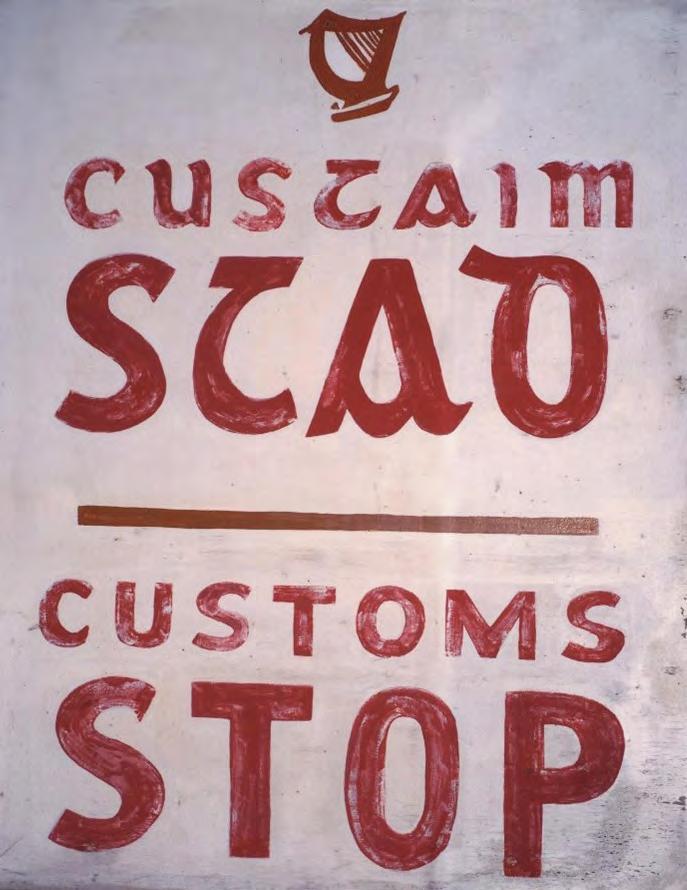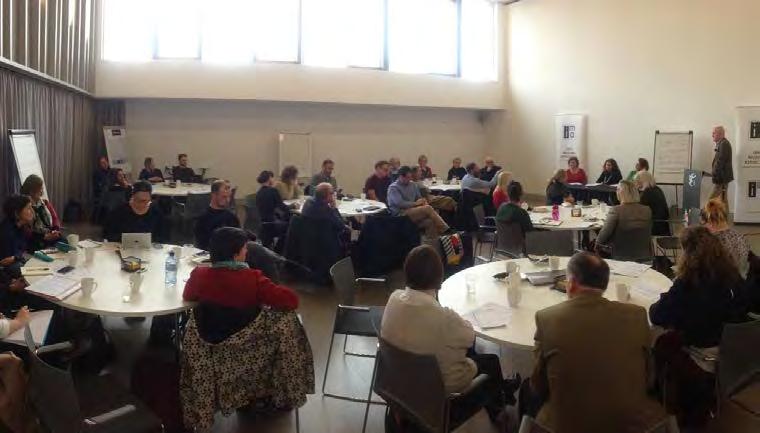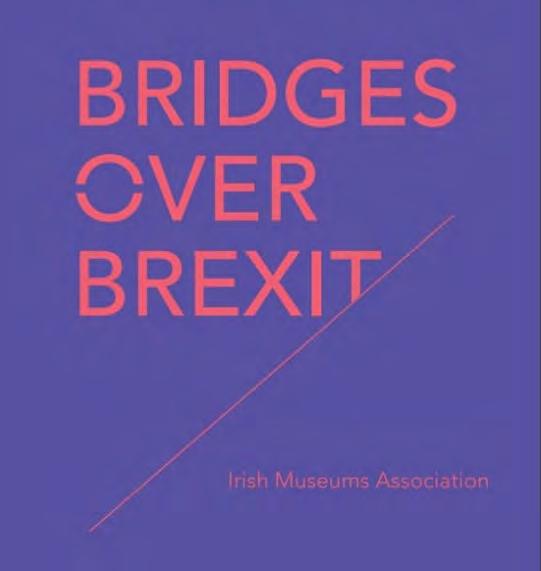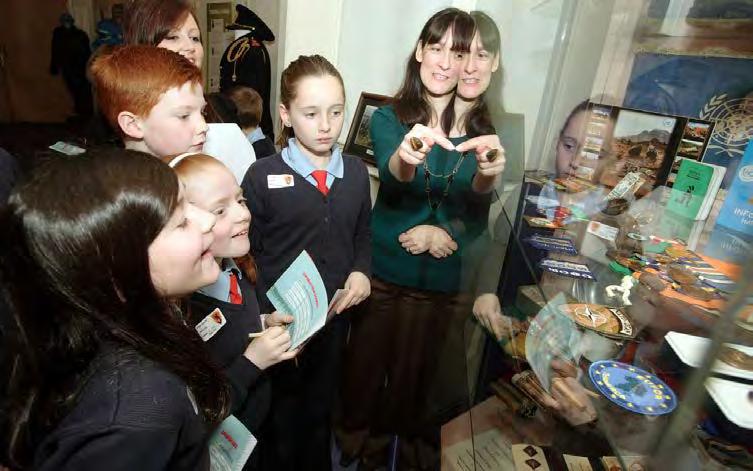
10 minute read
The EU as a driver of cross-border museum projects in Ireland: history, context, legacy and the future
from Museum Ireland, Vol. 27. Widdis, B. (Ed.). Irish Museums Association, Dublin (2021)
by irishmuseums
MUSEUM IRELAND 2020
The EU as a driver of cross-border museum projects in Ireland: history, context, legacy and the future
Advertisement
Catherine McCullough
Since the mid-1990s, cross-border museum projects on the island of Ireland have been driven by European Union (EU) intervention and support. The rationale, methods and working practices of these projects, which have focused on exploring histories, identities and cultural expressions on both sides of the border, have shaped creativity and impacted audiences, stimulating new thinking about the purposes, activities and intrinsic value of museums.
This paper documents a Collaborative Doctoral Award based at Ulster University, funded by the Arts and Humanities Research Council within the Northern Bridge Consortium.1 Working with the Irish Museums Association, the project started in October 2020 and will run until March 2024. It will provide insights into how EU cultural and peacebuilding strategies have impacted museum practice. It will garner new appreciation of how EU projects have shaped workforce skills, project development and audience engagement in the museum sector. It will also look to the future, at how the best of such projects can be nurtured and fostered, ensuring that cross-border cooperation can continue to grow and develop.
EU funding and the PEACE Programme 1995-2020
As the Troubles were beginning in Northern Ireland in the 1960s, both Ireland and Britain were negotiating to join the EU. Their achievement of membership of the European Economic Community in 1973 not only affected the constitutional and legal positions of both states, but also ensured their participation in EU institutions, altering their relationships with each other. This new dynamic encouraged local representatives to work together on the European stage, outside their habitual domestic platforms, allowing new alignments and partnerships to develop. The collaborative work of the Members of the European Parliament focused attention on Northern Ireland in a way that had never happened before, and was to the ultimate advantage of everyone on the island.
As a result of the IRA’s declaration of a permanent ceasefire in the summer of 1994, and with the strong support of President of the Commission Jacques Delors, the EU affirmed its ‘support for the ongoing peace process’, indicating that it was willing to provide additional funding.2 In December that year, at a European Council meeting in Germany, ‘the EU voted to prepare and fund a special programme to facilitate peace and reconciliation in Northern Ireland and the Border Region of Ireland’.3 This programme, now known as PEACE I-IV and not replicated in any other country of the Community, was a unique cross-border initiative with the avowed aim of embedding the peace process after the paramilitary ceasefires were confirmed. Since 1995 under the four iterations of EU PEACE funding, combined with European Regional Development Funds, INTERREG and match-funding from the
two governments, a total of €1.57 billion has been allocated to the border region.4 A proportion of this substantial sum has been allocated to crossborder museum programmes.
Border Customs Sign at Carrickarnon ROI, 1993.
Credit: Newry and Mourne Museum Collection
This Doctoral research project is investigating funded activity where border museums were the lead bodies or were beneficiaries, considering capital and programme funding, community engagement, programming activity and evidence of resulting creativity and further investment in the cross-border area. The level of funding demonstrates that the EU is a significant driver of cross-border museum projects between Northern Ireland and Ireland. However, the processes, character and rationale of these projects have not been fully investigated. Often associated with peacebuilding, these project and infrastructure monies have been vital to new cultural explorations and the sustenance of the peace process. In addition, whilst we are unsure as a sector of the final impact of the Brexit process on movement of people, collections, loan agreements, touring exhibitions, insurance and workforce diversity, we must take this opportunity to record and analyse the stimulus given to museum working practices by a quarter of a century of EU funding.
Sectoral reports from the Irish Museums Association and Ulster University
In 2018, the urgency of this research was flagged by the Irish Museums Association-Ulster University report Brexit and the Museum Sector in Northern Ireland and the Republic of Ireland.5 This report, based on open meetings of museum staff and guided by their input, made a number of important suggestions. It concluded that the sector must gather and evaluate data on crossborder funding, planning and practice, and on workforce, training and partnerships in order to understand more deeply the processes that have shaped museum practice, and should map pathways for the future.
Bridges Over Brexit, produced by the Irish Museums Association in 2019, examined eight cross-border projects and highlighted the ‘enormous potential to bring our communities together and discover commonalities, strengthening our society in the process’.6 However, the study also revealed a dearth of understanding of the character, content, working practices and legacy of cross- border museum-based projects. It is imperative that this information is captured and considered, so that the sector can continue to innovate and flourish regardless of the outcomes of Brexit. This project will therefore address a significant gap in our knowledge and understanding as we move into a changed political and policy environment.
Exiting the EU: Brexit impacts in early 2021
After much delay, the UK-EU trade agreement was finally agreed on Christmas Eve 2020, and the trade implications of exiting the European Union are currently playing out on the international stage. Major transport problems and significant food supply issues are currently impacting not just the business sector and hauliers, but also individuals in both Northern Ireland and the UK. The EU-UK Trade and Cooperation Agreement now affects freedom of movement, fisheries, judicial cooperation, state aid, energy and data protection, and most importantly for the purposes of this paper, will undoubtedly affect the funding of EU programmes.
Credit: Irish Museums Association

It is clear that, after almost half a century of membership, the impact of the UK leaving the European Union will continue to have an effect for some time to come, and in many areas of our lives. It is therefore vital that the museum sector considers the future of cross-border working in terms of peacebuilding, community cohesion, institutional partnerships, cultural relationships, workforce training and diversity. This study will ensure that the powerful body of work completed since the introduction of the PEACE funds in the mid-1990s is not forgotten.

Bridges Over Brexit Publication Cover.
Credit: Irish Museums Association
Project aims
Recent work has examined the role of the EU in Northern Ireland since 1981, with particular emphasis on the evolution of the peace process,7 but the impact of cross-border museum working has not been considered. The primary aim of the project is therefore to get a deeper understanding of the past, present and future relationships between the EU and the museum sector in Ireland and Northern Ireland. The study will place the history of museums in context and provide a comprehensive background to the development of collections, buildings and people. It will also, for the first time, examine and reflect on the impact of cultural programmes in the border area, providing new insights into the strategies, processes, rationale, character and working practices used to develop and deliver innovative and collaborative cross-community programming.
A further project aim is to significantly advance our understanding of the social and political dimensions of cultural policy and practice in a cross- border context. Working with museum staff, the study will consider the character, value and impact of EU funded museum projects, to ascertain their impact on community cohesion in the border region. This will include evaluation of how the workforce was equipped to undertake the delivery of these challenging programmes. Discussions with audiences who participated in museum projects may take place, allowing us to examine the lasting outcomes of these collaborative programmes. The intention is that the study will make recommendations on how museums can continue to deepen and sustain
Credit: Donegal County Museum and Paul McGuckin

cross-border creativity as we move into the new PEACE PLUS programme period (European Territorial Co-operation 2021-2027), currently under development.
Project approach: methods and rationale
Using a combination of policy analysis, data collection and case studies, the research will evaluate EU policy, examining the connections between the desired social and cultural outcomes and resultant museum practice in Northern Ireland and Ireland. By examining cultural heritage policy including collections care, management and movement of cultural goods; diversity and heritage integration procedures and cultural policy relevant to the peace process, the research will prioritise the areas which had the greatest impact on museum practice.
Through desk-based research, and in close collaboration with the museum sector, this project will gather qualitative and quantitative data relating to EU funded projects to museums and the voluntary and community sectors with whom they collaborate, including capital projects and project funding. Where possible, this data will include project documentation, such as funding applications, reports, and evaluation. It will document and assess the value of EU and linked funding; rationale and desired outcomes; working methods and priorities; partners and collaborations; and types of activity, such as audiences, collections, and exhibitions. Beginning with the period of SEUPB-funded PEACE IV (20142020) and PEACE III (2007-2013), the project will then review its methods and may collect data on earlier PEACE funding and other EU projects such as INTERREG.
A thematic case study analysis will be undertaken considering museums, culture and identity formation; cultural programming and peacebuilding and political and social dimensions of cultural policy. The detailed investigation of selected case studies will include material on project intent, rationale, methods, activities and evaluation. Interviews and workshops will be undertaken with museum and project staff. In partnership with the museums, workshops will, if possible, be held with collaborators and community groups who participated in the projects. This project will reach policy makers, through interviews, data collection and dissemination.
The voice of the sector
How often has the comment ‘Oh, I didn’t know that museums did that sort of thing’ been heard in reply to discussions about health and wellbeing interventions, public engagement projects, working with young people and dynamic digital programming? This new research project will deepen understanding of museum’s contributions in those areas. To this end, contributions are sought from those working on EU-funded projects in the museum sector on the island in relation to cross-border programming, case studies, workforce development and innovative approaches to developing links and cross-community ties. This is your chance to draw attention to all the
EU-funded work your museum has carried out over the last 25 years and ensure that these efforts are recorded and recognized. As we deal with the outworking of Brexit, the segregation of the COVID-19 pandemic means that in-person meetings are currently impossible. It is hoped that future workshops can be organised to enable the collection of data, to reflect on policy and to disseminate the work of the project.
All information in relation to your projects is welcome - please contact Catherine at McCullough-C36@ulster.ac.uk.
Catherine McCullough is a Doctoral Researcher on the Ulster University-Irish Museums Association Collaborative Doctoral project ‘The EU and the museum: an investigation of cross-border museum projects in Ireland’ funded by the AHRC through the Northern Bridge Consortium. Supervisors are Gina O’Kelly, Irish Museums Association; Professor Elizabeth Crooke, Cultural Heritage and Museum Studies and Dr Philip McDermott, Senior Lecturer in Sociology, Ulster University.
Partnership’, http://www.northernbridge.ac.uk/.
2. N. Piers Ludlow, ‘The Peace Programme for Northern
Ireland’, in The European Commission 1986-2000: History and Memories of an Institution., ed. Vincent Dujardin et al.
(Luxembourg: Publications Office of the European Union,
2019), 426–29, http://eprints.lse.ac.uk/101109/.
3. K Bush and K Houston, The Story of Peace, Learning from the EU PEACE Funding in Northern Ireland and the Border Region (Ulster University, INCORE, 2011). See
also ‘A Special Support Programme for Peace and
Reconciliation in Northern Ireland’, Commission
of the European Communities, 7 December 1994,
https://eur-lex.europa.eu/legal-content/EN/TXT/ PDF/?uri=CELEX:51994DC0607&from=EN.
4. Northern Ireland PEACE Programme, Fact Sheets on
the European Union, 2020 (European Parliament, 2020),
https://www.europarl.europa.eu/factsheets/en/sheet/102/
northern-ireland-peace-programme.
5. Elizabeth Crooke and Gina O’Kelly, Brexit and the Museum Sector in Northern Ireland and the Republic of Ireland (Dublin and Derry: Irish Museums Association and Ulster
University, 2018).
6. Gina O’Kelly, Bridges Over Brexit (Dublin: Irish Museums
Association, 2019).p.26.
7. G Lagana, The European Union and the Northern Ireland Peace Process (London: Palgrave Macmillan, 2021).









